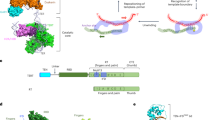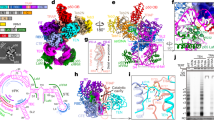Abstract
The ribonucleoprotein enzyme telomerase synthesizes DNA at the ends of chromosomes. Although the telomerase catalytic protein subunit (TERT) is well conserved, the RNA component is rapidly evolving in both size and sequence. Here, we reduce the 1,157-nucleotide (nt) Saccharomyces cerevisiae TLC1 RNA to a size smaller than the 451-nt human RNA while retaining function in vivo. We conclude that long protein-binding arms are not essential for the RNA to serve its scaffolding function. Although viable, cells expressing Mini-T have shortened telomeres and reduced fitness as compared to wild-type cells, suggesting why the larger RNA has evolved. Previous attempts to reconstitute telomerase activity in vitro using TLC1 and yeast TERT (Est2p) have been unsuccessful. We find that substitution of Mini-T for wild-type TLC1 in a reconstituted system yields robust activity, allowing the contributions of individual yeast telomerase components to be directly assessed.
*Note: In the supplementary information initially published online to accompany this article, the secondary structure model for a 436-nt mini-T is shown in Supplementary Figure 1, but the legend describes a 500-nt mini-T model. The secondary structure model for the 500-nt mini-T has now been supplied by the authors. The error has been corrected online.
This is a preview of subscription content, access via your institution
Access options
Subscribe to this journal
Receive 12 print issues and online access
$189.00 per year
only $15.75 per issue
Buy this article
- Purchase on Springer Link
- Instant access to full article PDF
Prices may be subject to local taxes which are calculated during checkout




Similar content being viewed by others
Change history
14 April 2006
File replaced
References
Cech, T.R. Beginning to understand the end of the chromosome. Cell 116, 273–279 (2004).
Shay, J.W. & Bacchetti, S. A survey of telomerase activity in human cancer. Eur. J. Cancer 33, 787–791 (1997).
Greider, C.W. & Blackburn, E.H. Identification of a specific telomere terminal transferase activity in Tetrahymena extracts. Cell 43, 405–413 (1985).
Lingner, J. et al. Reverse transcriptase motifs in the catalytic subunit of telomerase. Science 276, 561–567 (1997).
Greider, C.W. & Blackburn, E.H. A telomeric sequence in the RNA of Tetrahymena telomerase required for telomere repeat synthesis. Nature 337, 331–337 (1989).
Singer, M.S. & Gottschling, D.E. TLC1: template RNA component of Saccharomyces cerevisiae telomerase. Science 266, 404–409 (1994).
Dandjinou, A.T. et al. A phylogenetically based secondary structure for the yeast telomerase RNA. Curr. Biol. 14, 1148–1158 (2004).
Zappulla, D.C. & Cech, T.R. Yeast telomerase RNA: a flexible scaffold for protein subunits. Proc. Natl. Acad. Sci. USA 101, 10024–10029 (2004).
Tzfati, Y., Knight, Z., Roy, J. & Blackburn, E.H. A novel pseudoknot element is essential for the action of a yeast telomerase. Genes Dev. 17, 1779–1788 (2003).
Livengood, A.J., Zaug, A.J. & Cech, T.R. Essential regions of Saccharomyces cerevisiae telomerase RNA: separate elements for Est1p and Est2p interaction. Mol. Cell. Biol. 22, 2366–2374 (2002).
Seto, A.G., Livengood, A.J., Tzfati, Y., Blackburn, E. & Cech, T.R. A bulged stem tethers Est1p to telomerase RNA in budding yeasts. Genes Dev. 16, 2800–2810 (2002).
Peterson, S.E. et al. The function of a stem-loop in telomerase RNA is linked to the DNA repair protein Ku. Nat. Genet. 27, 64–67 (2001).
Seto, A.G., Zaug, A.J., Sobel, S.G., Wolin, S.L. & Cech, T.R. Saccharomyces cerevisiae telomerase is an Sm small nuclear ribonucleoprotein particle. Nature 401, 177–180 (1999).
Ban, N., Nissen, P., Hansen, J., Moore, P.B. & Steitz, T.A. The complete atomic structure of the large ribosomal subunit at 2.4 A resolution. Science 289, 905–920 (2000).
Evans, S.K. & Lundblad, V. The Est1 subunit of Saccharomyces cerevisiae telomerase makes multiple contributions to telomere length maintenance. Genetics 162, 1101–1115 (2002).
Mathews, D.H., Sabina, J., Zuker, M. & Turner, D.H. Expanded sequence dependence of thermodynamic parameters improves prediction of RNA secondary structure. J. Mol. Biol. 288, 911–940 (1999).
Feng, J. et al. The RNA component of human telomerase. Science 269, 1236–1241 (1995).
Thatcher, J.W., Shaw, J.M. & Dickinson, W.J. Marginal fitness contributions of nonessential genes in yeast. Proc. Natl. Acad. Sci. USA 95, 253–257 (1998).
Hughes, T.R., Evans, S.K., Weilbaecher, R.G. & Lundblad, V. The Est3 protein is a subunit of yeast telomerase. Curr. Biol. 10, 809–812 (2000).
Schiestl, R.H. & Gietz, R.D. High efficiency transformation of intact yeast cells using single stranded nucleic acids as a carrier. Curr. Genet. 16, 339–346 (1989).
Weinrich, S.L. et al. Reconstitution of human telomerase with the template RNA component hTR and the catalytic protein subunit hTRT. Nat. Genet. 17, 498–502 (1997).
Beattie, T.L., Zhou, W., Robinson, M.O. & Harrington, L. Reconstitution of human telomerase activity in vitro. Curr. Biol. 8, 177–180 (1998).
Collins, K. & Gandhi, L. The reverse transcriptase component of the Tetrahymena telomerase ribonucleoprotein complex. Proc. Natl. Acad. Sci. USA 95, 8485–8490 (1998).
Friedman, K.L., Heit, J.J., Long, D.M. & Cech, T.R. N-terminal domain of yeast telomerase reverse transcriptase: recruitment of Est3p to the telomerase complex. Mol. Biol. Cell 14, 1–13 (2003).
Cohn, M. & Blackburn, E.H. Telomerase in yeast. Science 269, 396–400 (1995).
Seto, A.G. et al. A template-proximal RNA paired element contributes to Saccharomyces cerevisiae telomerase activity. RNA 9, 1323–1332 (2003).
Morris, D.K. & Lundblad, V. Programmed translational frameshifting in a gene required for yeast telomere replication. Curr. Biol. 7, 969–976 (1997).
Schroeder, R., Barta, A. & Semrad, K. Strategies for RNA folding and assembly. Nat. Rev. Mol. Cell Biol. 5, 908–919 (2004).
Uhlenbeck, O.C. Keeping RNA happy. RNA 1, 4–6 (1995).
Prescott, J. & Blackburn, E.H. Telomerase RNA mutations in Saccharomyces cerevisiae alter telomerase action and reveal nonprocessivity in vivo and in vitro. Genes Dev. 11, 528–540 (1997).
Teixeira, M.T., Arneric, M., Sperisen, P. & Lingner, J. Telomere length homeostasis is achieved via a switch between telomerase-extendible and -nonextendible states. Cell 117, 323–335 (2004).
Schmitt, M.E., Brown, T.A. & Trumpower, B.L. A rapid and simple method for preparation of RNA from Saccharomyces cerevisiae. Nucleic Acids Res. 18, 3091–3092 (1990).
Chapon, C., Cech, T.R. & Zaug, A.J. Polyadenylation of telomerase RNA in budding yeast. RNA 3, 1337–1351 (1997).
Lei, M., Zaug, A.J., Podell, E.R. & Cech, T.R. Switching human telomerase on and off with hPOT1 protein in vitro. J. Biol. Chem. 280, 20449–20456 (2005).
Friedman, K.L. & Cech, T.R. Essential functions of amino-terminal domains in the yeast telomerase catalytic subunit revealed by selection for viable mutants. Genes Dev. 13, 2863–2874 (1999).
Acknowledgements
We thank A.J. Zaug (University of Colorado, Boulder, Colorado, USA) for plasmid T7-ProA-Est2p and A.G. Seto (present affiliation: Harvard Medical School, Cambridge, Massachusetts, USA) for telomerase immunopurified from yeast. Thanks also to A.J. Zaug for performing the telomerase activity assays that included human TERT. This research was supported in part by grant GM28039 from the US National Institutes of Health.
Author information
Authors and Affiliations
Corresponding author
Ethics declarations
Competing interests
The authors declare no competing financial interests.
Supplementary information
Supplementary Fig. 1
Mfold secondary structure model of Mini-T(500). (PDF 907 kb)
Supplementary Fig. 2
Mini-T(500) RNA accumulation when expressed from the chromosome. (PDF 355 kb)
Supplementary Fig. 3
Mini-T RNA levels during log phase cell growth. (PDF 734 kb)
Supplementary Fig. 4
Mini-T(64) and (67) do not yield reconstituted activity. (PDF 586 kb)
Supplementary Fig. 5
Reconstituted core mini-telomerase has activity very similar to wild-type telomerase from yeast. (PDF 1039 kb)
Rights and permissions
About this article
Cite this article
Zappulla, D., Goodrich, K. & Cech, T. A miniature yeast telomerase RNA functions in vivo and reconstitutes activity in vitro. Nat Struct Mol Biol 12, 1072–1077 (2005). https://doi.org/10.1038/nsmb1019
Received:
Accepted:
Published:
Issue Date:
DOI: https://doi.org/10.1038/nsmb1019
This article is cited by
-
Finding the end: recruitment of telomerase to telomeres
Nature Reviews Molecular Cell Biology (2013)
-
RNA connectivity requirements between conserved elements in the core of the yeast telomerase RNP
The EMBO Journal (2013)
-
RPA facilitates telomerase activity at chromosome ends in budding and fission yeasts
The EMBO Journal (2012)
-
TER1, the RNA subunit of fission yeast telomerase
Nature Structural & Molecular Biology (2008)
-
Triple-helix structure in telomerase RNA contributes to catalysis
Nature Structural & Molecular Biology (2008)



